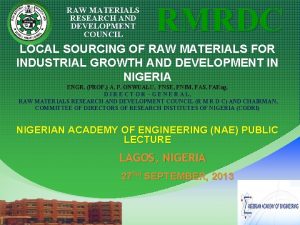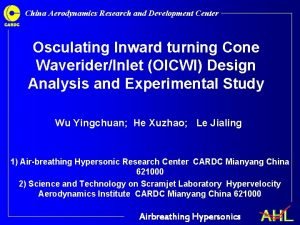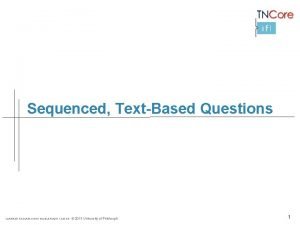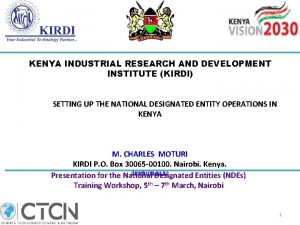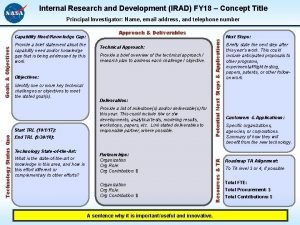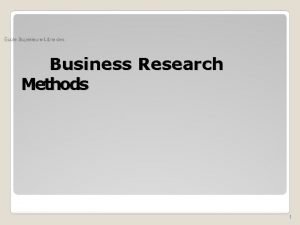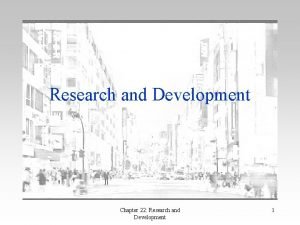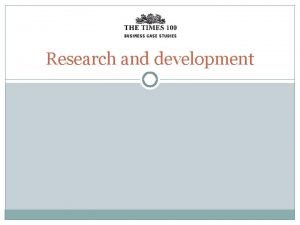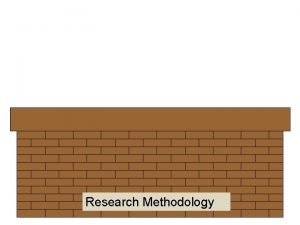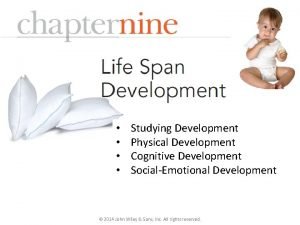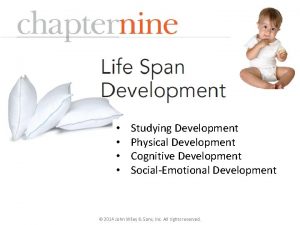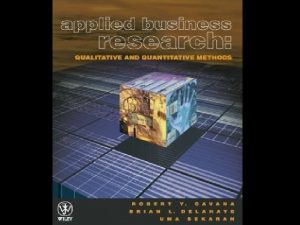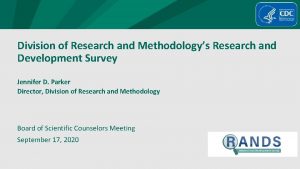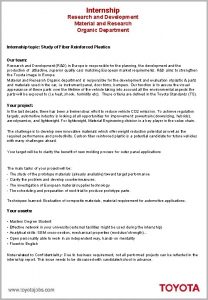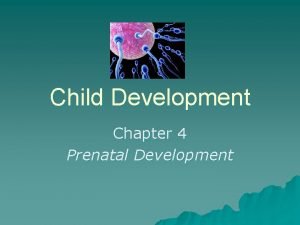Research and Development Chapter 22 Research and Development



















- Slides: 19

Research and Development Chapter 22: Research and Development 1

Introduction • Technical progress is the source of rising living standards over time • Introduces new concept of efficiency – Static efficiency—traditional allocation of resources to produce existing goods and services so as to maximize surplus and minimize deadweight loss – Dynamic efficiency—creation of new goods and services to raise potential surplus over time • Schumpeterian hypotheses (conflict between static and dynamic efficiency) – Concentrated industries do more research and development of new goods and services, i. e. , are more dynamically efficient, than competitively structured industries – Large firms do more research & development than small firms Chapter 22: Research and Development 2

A Taxonomy of Innovations Product versus Process Innovations • Product Innovations refer to the creation of new goods and new services, e. g. , DVD’s, PDA’s, and cell phones • Process Innovations refer to the development of new technologies for producing goods or new ways of delivering services, e. g. , robotics and CAD/CAM technology • We mainly focus on process or cost-savings innovations but the lines of distinction are blurred—a new product can be the means of implementing a new process Drastic versus Non-Drastic Innovations • Process innovations have two further categories • Drastic innovations have such great cost savings that they permit the innovator to price as an unconstrained monopolist • Non-drastic innovations give the innovator a cost adavantage but not unconstrained monopoly power Chapter 22: Research and Development 3

Drastic versus Non-Drastic Innovations • Suppose that demand is given by: P = 120 – Q and all firms have constant marginal cost of c = $80 • Let one firm have innovation that lowers cost to c. M = $20 • This is a Drastic innovation. Why? – Marginal Revenue curve for monopolist is: MR = 120 – 2 Q – If c. M = $20, optimal monopoly output is: QM = 70 and PM = $70 – Innovator can charge optimal monopoly price ($70) and still undercut rivals whose unit cost is $80 • If cost fell only to $60, innovation is Non-drastic – Marginal Revenue curve again is: MR = 120 = 2 Q – Optimal Monopoly output and price: QM = 30; PM = $90 – However, innovator cannot charge $90 because rivals have unit cost of $80 and could under price it – Innovator cannot act as an unconstrained monopolist – Best innovator can do is to set price of $80 (or just under) and supply all 40 units demanded. Chapter 22: Research and Development 4

Non. Drastic Innovation: QM < QC Drastic Innovation: QM > QC so Drastic vs. Non-Drastic Innovations (cont. ) so innovator cannot charge innovator can charge monopoly M because rivals M without constraint monopoly price P M price P Innovation is drastic if monopoly output Q at MR = new marginal c’ exceeds the competitive output QC atcan oldundercut marginalthat costprice c $/unit = p c PM c’ Demand MR QC QM MR Quantity QM QC Chapter 22: Research and Development Quantity 5

Innovation and Market Structure • Arrow’s (1962) analysis— – Innovative activity likely to be too little because innovators consider only monopoly profit that the innovation brings and not the additional consumer surplus – Monopoly provides less incentive to innovate that competitive industry because of the Replacement Effect • Assume demand is: P = 120 – Q; MC= $80. Q is initially 40. Innovator lowers cost to $60 and can sell all 40 units at P = $80. • Profit Gain is $800–Less than Social Gain $/unit 120 80 60 A B 40 60 Initial Surplus is Yellow Triangle--Social Gains from Innovation are Areas A ($800) and B ($200) But Innovator Only Considers Profit Area A ($800) Quantity 120 Chapter 22: Research and Development 6

Innovation and Market Structure (cont. ) • Now consider innovation when market structure is monopoly – Initially, the monopolist produces where MC = MR = $80 at Q = 20 and P = $100, and earns profit (Area C) of $400 – Innovation allows monopolist to produce where MC = MR = $60 at Q = 30 and P = $90 and earn profit of $900 – But this is a gain of only $500 over initial profit due to Replacement Effect—new profits destroy old profits $/unit 120 100 90 80 60 C A 20 30 MR 60 Monopolist Initially Earns Profit C—With Innovation it Earns Profit A—Net Profit Gain is Area A – Area C Which is Less than the Gain Demand to a Competitive Firm 120 Chapter 22: Research and Development Quantity 7

Innovation and Market Structure (cont. ) • Preserving Monopoly Profit--the Efficiency Effect • Previous Result would be different if monopolist had to worry about entrant using innovation – Assume Cournot competition and that entrant can only enter if it has lower cost, i. e. , if it uses the innovation – If Monopolist uses innovation, entrant cannot enter and monopolist earns $900 in profit – If Monopolist does not use innovation, entrant can enter as lowcost firm in a duopoly • Entrant earns profit of $711 • Incumbent earns profit of $44 – Gain from innovation now is no longer $900 - $400 = $500 but $900 - $44 = $856 – Monopolist always has more to gain from innovation than does entrant—this is the Efficiency Effect Chapter 22: Research and Development 8

Competition and Innovation • The incumbent/entrant model just discussed seems closer in spirit to Schumpeter’s ideas than Arrow’s analysis. • Dasgupta and Stiglitz (1980) come even closer by directly embedding innovation in a model of Cournot competition – – – Profit for each firm: i = P(Q) – c(xi)qi – xi Here, firm’s unit cost falls as the firm engages in R&D activity What is the equilibrium? Define x* as the optimal R&D level of each firm From Chapter 9, we know that –But with n symmetric firms si = 1/n, So we have Output Condition Chapter 22: Research and Development 9

Competition and Innovation (cont. ) • How much should x* be? – The usual marginal calculations apply. Every increase in x costs $1. The benefit is the cost reduction this brings, c(x)/ x, times the number of units q* to which this cost reduction will apply R&D Condition – Both the Output Condition and the R&D Condition must hold simultaneously in any equilibrium – One obvious implication of the R&D Condition is that the R& D effort of any one firm will fall as the number of n firms increases because this will decrease the output of each firm Chapter 22: Research and Development 10

Competition and Innovation (cont. ) • Making n endogenous means allowing firms to enter until they no longer have an incentive to do so • This will occur when firms earn zero profit after allowing for R&D costs. Defining n* as the equilibrium number of firms, the Output Condition then implies: • Substitution into the R&D Condition then yields: Industry R&D as Share of Sales • Industry R&D effort declines as n* rise, i. e. , as industry becomes less concentrated—fairly strong theoretical support for Schumpeterian Hypothesis Chapter 22: Research and Development 11

Competition and Innovation (cont. ) • But empirical support for Schumpeterian view is mixed – Need to control for science-based sectors (e. g. , chemicals, pharmaceuticals, and electronics) and non-technology based sectors (e. g. , restaurants and hair stylists)—R&D much more likely in science-based sectors regardless of firm size – Need also to distinguish between R&D expenditures and true innovations. Common finding [e. g. , Cohen and Klepper (1996)], is that large firms do somewhat more R&D but achieve less real innovative breakthroughs—e. g. , Apple produced the first PC – Market structure is endogenous. Innovations might create industry giants (e. g. , Alcoa) not the other way around. • Bottom Line: Validity of Schumpeterian hypotheses is still undetermined Chapter 22: Research and Development 12

R&D Spillovers and Cooperative R&D • Technological break-throughs by one firm often “spill over’ to other firms – Spillover is unlikely to be complete but likely to arise to some extent – We can model this in the Dasgupta Stiglitz world by now writing a firm’s unit cost as a function of both its own and its rival’s R&D • c 1 = c – x 1 - x 2 • c 2 = c – x 2 - x 1 • To obtain solution, need also to assume that R&D is now subject to diminishing returns, i. e. , R&D cost is r(x) = x 2/2. • In this setting, response of firm 1’s R&D to firm 2’s R&D depends on size of spillover term . – When is small, R&D expenditures are strategic substitutes—the more firm 1 does the less firm 2 will do – When is large, R&D expenditures are strategic complements—the more firm 1 does the more firm 2 will do Chapter 22: Research and Development 13

R&D Spillovers and Cooperative R&D (cont. ) • However, determination of whether R&D efforts are strategic substitutes or strategic complements is not sufficient to determine what happens when there are spillovers – Let Demand be given by: P = A – BQ – Let ci = c – xi – xj; – Each firm now chooses both production qi and research intensity xi – To make things simple, suppose that A = 100, B = 2; and that firms have to choose between setting x at either 7. 5 or 10 • Now consider two cases – First case: Low Spillovers; = 0. 25 – Second case: High Spillovers; = 0. 75 Chapter 22: Research and Development 14

sh Equilibrium is for both firms to oose the high level of research ensity (x. R&D = 10). Spillovers Why? When degree and Cooperative R&D (cont. ) spillovers is small, firm know that The Pay-Off Matrix for = 0. 25 ts rival can do R&D knowing that it l get most of the benefits. Since this Firm 1 uld advantage the rival, each firm es to avoid being left behind by doing s of R&D Low Research High Research Intensity Low Research $107. 31, $107. 31 $100. 54, $110. 50 Intensity Firm 2 High Research $110. 50, $100. 54 $103. 13, $103. 13 Intensity Chapter 22: Research and Development 15

sh Equilibrium is for both firms to oose the low level of research intensity = 7. 5). R&D Why? When degree of and Cooperative R&D (cont. ) Spillovers is large, firm knows that it The Pay-Off Matrix for = 0. 75 l benefit from technical advance of its al even if it doesn’t do any R&D itself. Firm 1 each firm tries to free-ride off its rival d each does little R&D Low Research High Research Intensity Low Research $128. 67, $128. 671, $136. 13, $125. 78 Intensity Firm 2 High Research $125. 78, $136. 13 Intensity Chapter 22: Research and Development $133. 68, $133. 68 16

R&D Spillovers and Cooperative R&D (cont. ) • MORAL of the foregoing analysis is that the Outcome of non-cooperative R&D spending depends critically on the extent of spillovers. • What if R&D spending is cooperative? • R&D cooperation can take two forms: – 1. Do R&D independently but choose x 1 and x 2 jointly to maximize combined profits, given competition in product market is maintained. – 2. Do R&D together as one firm, e. g, form a Research Joint Venture. That is, effectively operate as though the degree of spillovers is = 1, again though, continue to maintain product market competition. • The two types have very different implications. Chapter 22: Research and Development 17

R&D Spillovers and Cooperative R&D (cont. ) • Consider first the case of coordinated but not centralized R&D using our generalized demand cost equations – Total R&D spending now rises unambiguously as increases. – To see this note that given our earlier demand cost assumptions, and given the fact that x 1 and x 2 are chosen to maximize joint profits, the optimal values for x 1 and x 2 are: – This is unambiguously increasing in but this is a good news/bad news story. – The good news is that for the high spillover case ( >1), the freeriding problem is no longer an issue and firms now do more R&D – The bad news is that for the low spillover case ( < 1), there is no longer a fear of being left behind by one’s rival. So in this case firms do less R&D which means costs (and consumer prices) are higher. Chapter 22: Research and Development 18

R&D Spillovers and Cooperative R&D (cont. ) • What about a Research Joint Venture? – As noted, this effectively changes to 1. – For our general demand cost equations, it can be shown that: – This is clearly more R&D than occurred with simple coordination for any given value of – As a result, it leads to lower costs and more output to the benefit of consumers – Profits are also higher. Thus, in the presence of spillovers, Research Joint Ventures are unambiguously beneficial. – The only trick is to make sure that cooperation is limited to research and does not spill over to other dimensions of competition Chapter 22: Research and Development 19
 Raw materials research and development council
Raw materials research and development council Microsoft new england research and development center
Microsoft new england research and development center China aerodynamics research and development center
China aerodynamics research and development center Learning research and development center
Learning research and development center National space research and development agency
National space research and development agency Research and development logo
Research and development logo Educational research and development
Educational research and development Pfizer worldwide research and development
Pfizer worldwide research and development Research and development contracts
Research and development contracts Journal of rehabilitation research & development
Journal of rehabilitation research & development Ohio agricultural research and development center
Ohio agricultural research and development center Kirdi logo
Kirdi logo Irad research and development
Irad research and development National aquatic resources research and development agency
National aquatic resources research and development agency Diversity and human needs and development
Diversity and human needs and development Difference between applied research and basic research
Difference between applied research and basic research Contrast applied research and basic research
Contrast applied research and basic research Operational thought
Operational thought Applied vs fundamental research
Applied vs fundamental research Conclusive research design example
Conclusive research design example
